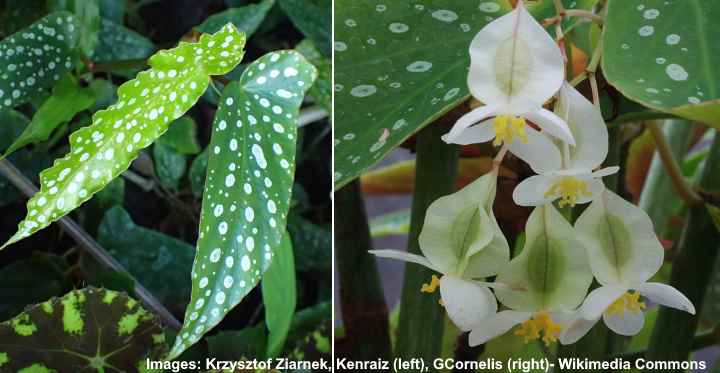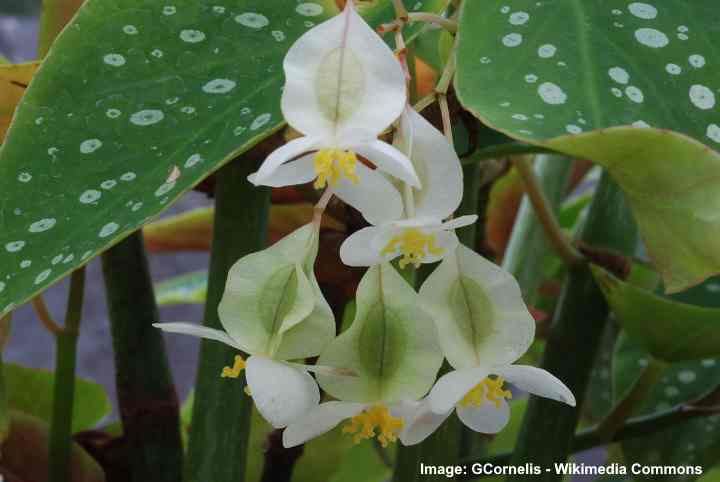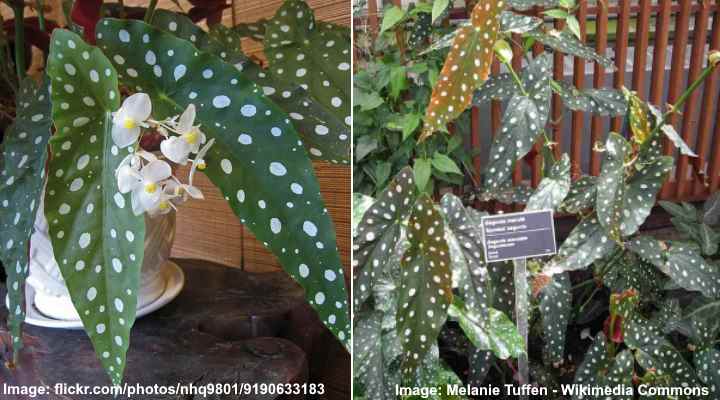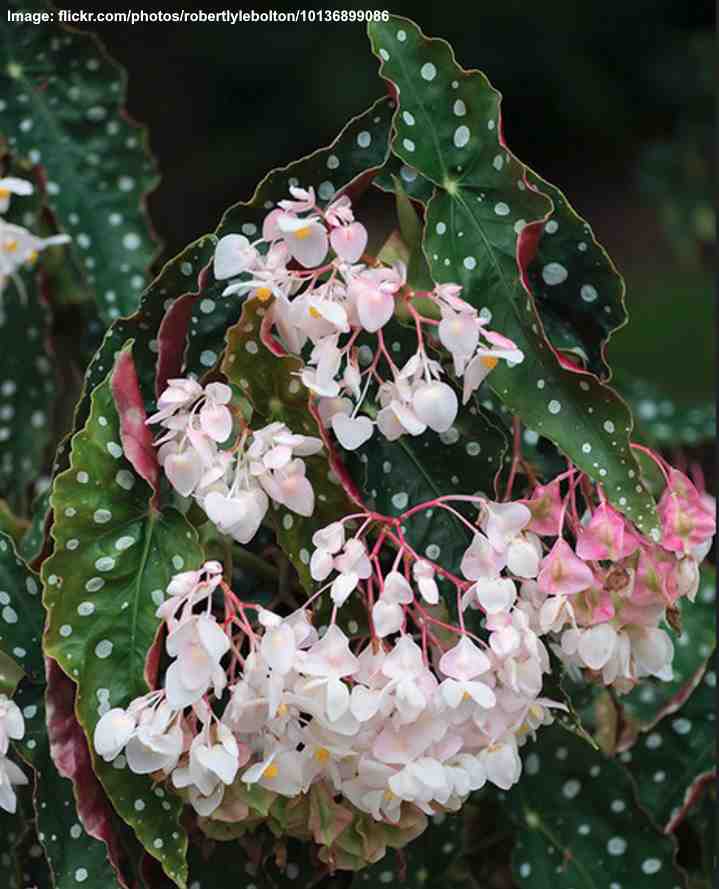Begonia Maculata Care: How to Grow Polka Dot Begonia (Wightii)

Begonia maculata is also called the polka dot begonia due to its silver-spotted leaves. The silvery spots on the dark, olive-green angel wing-shaped leaves create striking foliage. This eye-catching houseplant is relatively easy to care for indoors. The spotted begonia—also called ‘Wightii’—must be one of the most dramatic indoor plants you can grow.
How to care for begonia maculata: Polka dot begonia (Wightii) needs well-draining soil, and the pot should be in bright, indirect light. The soil should be slightly dry before watering, and humidity levels should be high—over 45%—and the temperature between 65°F and 86°F (18°C – 30°C). For best results, feed every two to four weeks and prune regularly. Easy propagation is by placing stem cuttings in water.
Having a begonia maculata in your room will instantly grab everyone’s attention. The silver polka dots on the leaves could be mistaken for splashes of paint. The leaves are in the shape of an angel’s or bat’s wings. Turning the leaves over reveals stunning crimson-red undersides. Although begonias are famous for their spectacular foliage, the begonia maculata Wightii is at the top of the list of beautiful indoor plants.
In this article, you will learn how to care properly for a begonia polka dot houseplant. We will also share tips on how to resolve common problems that can affect the fabulous begonia maculata.
Begonia Maculata: Overview

Begonia maculata has spotted foliage, hence it is also called polka dot begonia
Begonia maculata is a type of cane begonia that has thick stems that support spotted angel wing-shaped leaves. These evergreen perennial plants are native to the tropical rainforests in Brazil. Because of their native environment, high humidity, warm temperatures, and indirect or filtered light are the essential care factors.
Polka dot begonias are vigorous growers, and can soon outgrow their pot. Transferring to a larger container encourages growth where the plant can reach 5 ft. (1.5 m) tall. Under the right conditions, the spotted dark green leaves will contrast with clusters of delicate white flowers when the plant blooms.

Begonia maculata flowers
How to Care for Polka Dot Begonia
Even though begonia maculata is relatively easy to look after, it has some specific care requirements. The five basic care requirements are:
- Humidity—Keep humidity levels high by regularly misting to prevent leaf drop.
- Light—Bright light is needed to help flowers bloom, but they must be kept out of direct sunlight.
- Soil—Aerated, well-draining potting mix that holds enough moisture without becoming soggy.
- Temperature—Average room temperatures are ideal as long as they are kept out of drafts.
- Fertilizer—Balanced fertilizer is necessary once or twice a month during the growing season.
Let’s look in more detail at how to care for a begonia maculata Wightii.
Light Requirements for Begonia Maculata (Wightii)

Angel wing begonias like bright light to thrive, but they need to be protected from direct sunlight. Although they tolerate some shade, bright filtered light is ideal. The best place for a potted polka dot begonia indoors is on an east- or west-facing windowsill. In a south-facing room, keep the plant pot away from the window to prevent the sun from scorching the leaves.
The health of the spotted green leaves is an excellent way to know if your begonia Wightii is getting enough light. Too little light—and you will notice that the leaves lose their vibrancy. The green and silver colors may fade and eventually turn yellow. Too much sunlight—and the leaves may show signs of scorching and develop brown, crispy tips.
If you live in warm climates and you grow silver spotted-leaf begonias outdoors, choose a bright but shaded area of your garden. Part shade or dappled sunlight prevents the sun from burning the begonias leaves. The same care advice is applicable if you transfer your indoor potted begonias outside in summer.
How to Water Begonia Maculata
Water your begonia plants whenever the top part of the soil is dry, and the lower part is still moist. In summer, you may have to water the begonia weekly and in winter less often. However, the dryness of the soil determines when to water a begonia.
When caring for your maculata plant, the goal of watering is never to have the soil mix too dry or too moist. Poke your finger in the soil. It the top feels dry and there is moisture below, it is a sign to water your begonia.
Deep watering is better for your begonia maculata than shallow watering. Pour enough water through the soil until it drains out the drainage holes in the bottom of your pot. Wait until all the water drains before placing your plant back in a bright location. Watering your begonia this way ensures that the roots get enough moisture.
Top watering tip for begonias: only water the soil and avoid splashing water on the leaves.
How to Choose the Right Soil for Polka Dot Begonias
Having the right soil for begonia maculata plants is essential because it allows the water to drain well. The perfect potting medium for silver spotted begonias is light potting soil mixed with some perlite and wood chips. You could also combine sand, clay, perlite, and loamy soil to create a begonia potting mix.
Apart from draining well, a light, loamy soil that is aerated also helps with another care aspect. Oxygen circulates better in lighter soil, allowing the plant to absorb nutrients and thrive.
Polka Dot Begonia Humidity Needs
One of the most critical aspects of begonia maculata care is getting the humidity right. Begonias need at least 45% humidity and that is more than the average room. The three ways to get the air moisture levels right are these: grow them together with other plants, place on a pebble water tray, or use a humidifier.
Caring for begonia maculata plants is challenging in winter. Household heating dries out the air and the dry conditions can kill your houseplants.
If you don’t have a room humidifier, create a humidifying water tray. To make your tray, place a layer of pebbles in a shallow tray. Pour in enough water until it reaches half-way up the stones. Then place the pot on the pebbles. As the water evaporates naturally, it will provide moisture for the leaves. Only make sure that the pot never sits in the water.
Should you mist the leaves of polka dot begonias to boost humidity? Some websites recommend misting begonia leaves to increase humidity. However, begonias are susceptible to powdery mildew, and damp leaves may encourage this disease.
If your only option is to mist, make sure you have a fine spray and don’t mist the leaves directly. Lightly spray the air over and around the begonia plant.
The Right Temperature for Begonia Maculata
Even though begonia maculata plants come from tropical rainforests, average room temperatures are ideal. The ideal temperature range for polka dot begonias is between 65°F and 86°F (16°C – 30°C). Remember to keep the houseplant out of drafts as they can chill your indoor plant too much.
As an outdoor plant, begonia maculata grows in USDA zones 10 and 11. They will grow well where water drains and there is partial shade.
If you have your begonia maculata in pots outdoors in summer, bring them inside when the temperature starts dropping to 60°F (15.5°C). Any temperature below 59°F (15°C) can kill off your stunning polka dot begonia.
Fertilizing Needs to Care for Begonia Maculata
Feed begonias with a balanced fertilizer—nitrogen, phosphorus, and potassium in equal quantities. Feed every two to four weeks in the months between April and September. The nutrient mix will keep the spotted green and silver foliage healthy and vibrant.
Here are some essential feeding tips when it comes to looking after your begonia maculata:
- Flush the soil regularly—Flushing with water helps to prevent a buildup of mineral salts. Every two to three months, pour plenty of water through the soil and allow it to drain. Resume feeding two weeks later.
- Stop feeding in fall and winter—Begonias grow slowly between October and March and don’t need fertilizer.
- Feed moderately—Too much fertilizer can damage your plant.
Brown tips that blight the beautiful leaves are a sign of over-rich soil. Flush the soil and repot your begonia in fresh potting mix if necessary.
Begonia Maculata Flowers

Under the right conditions, polka dot begonias produce clusters of light pink or white flowers. The blooming season is spring until late summer. When in full bloom, begonia maculata plants are at their most stunning—olive green polka dot leaves with copper-red undersides and clusters of delicate pale flowers.
How do you keep begonias blooming? The best way to ensure that your polka dot flowers is to put the pot in a bright place. Try putting on a windowsill that faces east or west to get morning or evening sun. Begonias also thrive when they are slightly rootbound, so that can also encourage flowers to bloom.
You don’t have to deadhead begonia maculata plants. The old flowers fall off themselves after blooming. However, you can deadhead begonias if you want your plant to grow more stems.
How to Prune Polka Dot Begonias
Pruning begonia maculata Wightii plants is an essential part of their care if you want a spectacular bushy potted houseplant. To prune your plant, pinch about one-quarter inch (0.6 cm) from the top of the stem. Pruning encourages begonias to grow outward rather than upward.
The best time to prune a begonia maculata is in late fall. At this time, the growing season has finished, and your plant will rest over the winter. You can also pinch off small stems throughout the growing season. Your plant will grow bushier because two new stems will grow in place of one.
Easy Begonia Maculata Propagation
One of the delights of caring for a spotted begonia Wightii is that they are easy to propagate. Growing new plants from cuttings lets you increase the number of potted houseplants. You can also delight your friends by gifting one of these unusual tropical plants.
Here are instructions on how to propagate begonia maculata:
- Cut a stem so that there are at least two nodes on it.
- Place the cuttings in a jar of water.
- Wait for a few weeks until roots appear.
- Plant the begonia in a pot with fresh potting mix.
Repotting Begonia Maculata Wightii
Even though begonia polka dot Wightii plants like to be slightly rootbound, repotting once a year is advisable. Repotting helps to refresh the soil, give the roots more room to breathe, and improve drainage. When choosing a new pot, choose one that is 2” (5 cm) wider than its current one.
A terracotta pot with drainage holes is the best kind of container for begonias. The heavy pot gives the plant stability and prevents tall begonias from falling over. Just remember that moisture evaporates from clay pots faster than from plastic ones. So, you’ll have to keep your eye on soil dryness and make sure to water it adequately.
How to repot an angel wing spotted begonia:
- Gently remove the plant from the pot, taking care not to snap the stems.
- Shake off excess soil and loosen the roots—untangle if necessary.
- Check for signs of root disease or damage and snip these off with sterile scissors.
- Hold the begonia plant in the new pot and fill with new, moist, fresh potting mix.
- Ensure that the plant is at the same height as it was in the previous pot.
- Water thoroughly and only fertilize after four weeks.
Begonia Maculata Care: Diseases and Pests
Many common houseplant diseases can be avoided with your angel wing begonia if you get moisture and humidity levels right. Avoid allowing the leaves to get too damp and always sterilize tools before pruning. However, sometimes houseplant pests and diseases can afflict your polka dot begonia.
Fungal diseases or bacterial diseases that affect begonias include powdery mildew, leaf spot, botrytis, and Pythium root rot. You can avoid most of these harmful plant diseases by only watering begonias when the soil is partly dry. Also, avoid getting the leaves wet when watering.
Common houseplant pests that can affect begonia maculata plants are mealybugs and whiteflies. Mealybugs look like tiny white fluff that congregates where leaf stems join main stems. Whiteflies are small white-colored insects usually found under leaves. These pests can suck your plant dry if you don’t deal with them quickly.
Please read this article for advice on getting rid of houseplant pests naturally and organically.
Is Begonia Maculata Toxic?
Spotted begonia maculata plants are toxic to cats, dogs, and other family pets. The American Society for the Prevention of Cruelty to Animals (ASCPA) says that animals that eat parts of begonias can suffer from vomiting and excessive drooling.
FAQ: Growing Begonia Maculata Wightii
Here are answers to common questions about problems that can affect angel wing begonias.
Why are the polka dot begonia leaves turning brown or yellow?
The most common reason for yellow begonia maculata leaves is over-watering. If the soil is partly moist and you’ve been watering correctly, other reasons could be inadequate or excessive lighting, nutrient deficiency, or pest infestation. Also make sure your plant isn’t sitting in a drafty area.
Why is begonia maculata dropping leaves?
The most critical requirement to care for begonias is to get humidity right. Make sure that air circulates well and there is enough humidity for the plant. Also, check that your plant is getting plenty of bright light without being in direct sunlight.
How can I revive a dying begonia maculata?
The best way to try and save a polka dot begonia that is looking poorly is to repot it.
Related articles:
